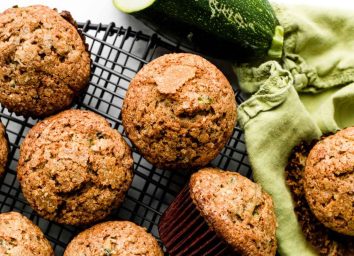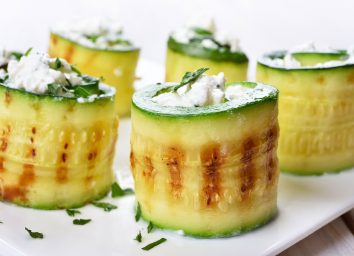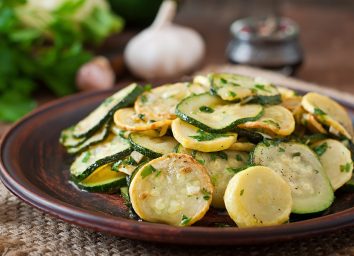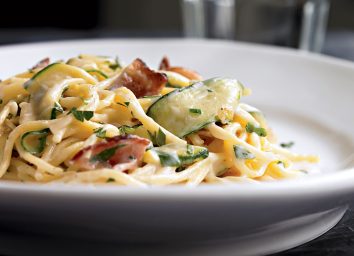What Is Zucchini, and Why Should You Eat It?
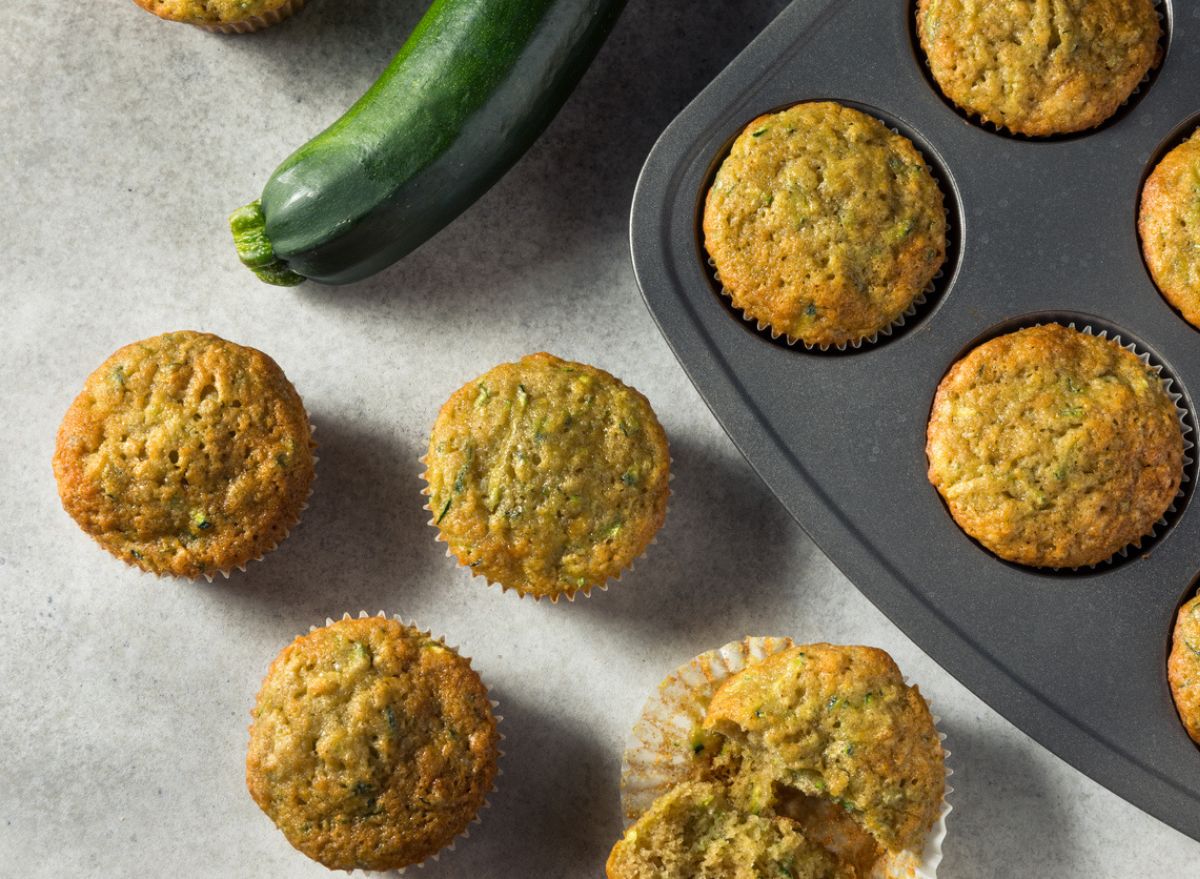
If you're trying to add more plants to your diet, zucchini is as an incredibly versatile option to incorporate into recipes. Its flavor isn't overwhelming, making it a successful addition to baked goods or a satisfying substitute for pasta. The summer squash is also great by itself, sautéed, grilled, or roasted. Plus, it's perfect to serve with any protein. Not only is zucchini simple to use, but it's also extremely beneficial to your health. It's no wonder you should add this high-fiber food to your diet this summer.
Here are some of the things you should know about zucchini, including when it's in season, what some of its health benefits are, and how to make zucchini noodles at home.
What is zucchini?
You might think of zucchini as a vegetable, but it's actually a young fruit that belongs to the Cucurbitaceae plant family, alongside other favorites like cucumbers and gourds. Zucchini is harvested before it fully matures, and it's categorized as a type of summer squash. It's totally edible, too: The skin, seeds, and flesh are all full of phytonutrients. In terms of color, it can range from a dark, emerald green to a yellowish hue.
What does it taste like?
The best way to describe zucchini's taste is mild. While it's a little bit sweet, it mostly takes on the characteristics of how it is cooked. Sauté it in olive oil with a little garlic, and it becomes a crispy carrier of that savory flavor. Purée it and add it to muffins, and it becomes a sweet addition to the batter. The summer squash adds to a dish and never overpowers the other flavors. That's why it's such an easy (and nutritious!) addition to so many foods.
How do you make and cook zucchini noodles?
This might just be the most popular way of enjoying the summer squash. You can make zucchini noodles with quite a few tools in the kitchen, so don't worry if you don't have a spiralizer. A potato peeler, run down the fruit lengthwise, makes thin strips, culinary scientist Jen Gavin writes on her website. Plus, a chef's knife can cut in the same direction to produce noodles. The best are small, ¼-inch in diameter at least, and as long as the fruit allows, according to Gavin.
Spiralizers, meanwhile, are special cutting equipment that allows you to feed the zucchini into the machinery and process it into perfect pasta shapes. They come in a handheld version, where you push it through yourself, or the countertop spiralizer, which has a hand crank.
Cooking zucchini noodles is easy. Simply sautéing them with olive oil, salt, and pepper will bring out the flavor and add to the texture of the spiralized noodles. Zucchini is also a perfect, low-carb replacement for typical spaghetti, and the spiralized noodles go well with any type of pasta sauce.
At C & S Seafood and Oyster Bar in Atlanta, Georgia, executive chef and owner Jon Schwenk serves fine dining Southern seafood, and he uses zucchini cut into pasta shapes, too.
"We serve spaghetti zucchini at work. A Japanese mandolin will give you perfect cuts that resemble spaghetti or linguine," Schwenk says. "On a smoking hot pan with olive oil, add sliced garlic. Ten seconds before it burns, add zucchini and cook for 30 seconds. Season with salt and pepper, and put it out of the pan to the plate adding finely shredded Parmesan or Pecorino. Finish with toasted sliced almonds."
What are some creative ways to use zucchini?
If you really want to get creative, the ways to use zucchini are endless. Zucchini purée can be added to the batter in everything from muffins to cakes and cookies. Its relatively mild flavor doesn't compete with the taste of baked goods, so it's a great choice to add to muffins, bread, cakes, bars, or even brownies.
It can also be roasted in the oven or used as a base for pizza.
Pam Hoffstetter, RD, LD, blends the summer squash and adds it to many savory dishes, too. "I blenderize it into really small pieces that I put into my turkey chili with lots of legumes. Also, in spaghetti sauce," the RD says.
And if you really want to get creative, pickled zucchini tastes like sweet bread and butter pickles, a fresh favorite at the end of the summer season.
When is it in season?
Zucchini starts to appear as soon as the weather turns warm and the frost has disappeared. With a relatively short growing season compared to other fruits on the vine, zucchini is best enjoyed in June through August. During the summer months, you're likely to find it everywhere in the farmers markets.
Can you freeze it?
The summer squash can easily be frozen if you aren't able to use it within a few days of purchase. For the best results, pick a young, small squash, wash it, and cut it into pieces. Blanch the ¼" slices for three minutes in boiling water, and then immediately plunge them in an ice water bath. Drain off the water, place the slices in a freezer-safe container, and write the date on the package. Frozen fruit lasts for about a year, so freezing summer zucchini can help you enjoy the harvest all the way to the next growing season.
What are the health benefits of zucchini?
Hoffstetter sees many reasons to include it in your diet. "It's a non-starchy vegetable. It's low in calories with no fat, high in fiber. It's a filler food for weight loss because of the fiber content. It helps keep blood sugar stable, regulates bowels, and improves your gut health," the RD says.
Vitamins A and C, which are found in zucchini, can also boost your immune system and help with vision. Don't peel the skin off, though. "The dark green skin has the most vitamins," Hoffstetter says.
What's the nutritional breakdown of zucchini?
Whether you eat zucchini raw or cooked will impact its nutritional breakdown, but you're getting plenty of nutrients however you eat it. Raw zucchini will contain more vitamin C, while cooked zucchini has more vitamin A. In one medium raw zucchini, you'll get just 33 calories, along with two grams of fiber and more than two grams of protein. And in addition to vitamins A and C, zucchini also contains a few of the B vitamins, potassium, and manganese.
Zucchini can be a tasty, beneficial addition to every category of food. It blends well into all kinds of recipes, but as Chef Schwenk tells us, it's sometimes best by itself. "I love the freshness of zucchini, especially when it's in season on the East Coast," Schwenk says. A fresh, in-season option that's packed with nutrients? However you prepare it, you can't go wrong.
